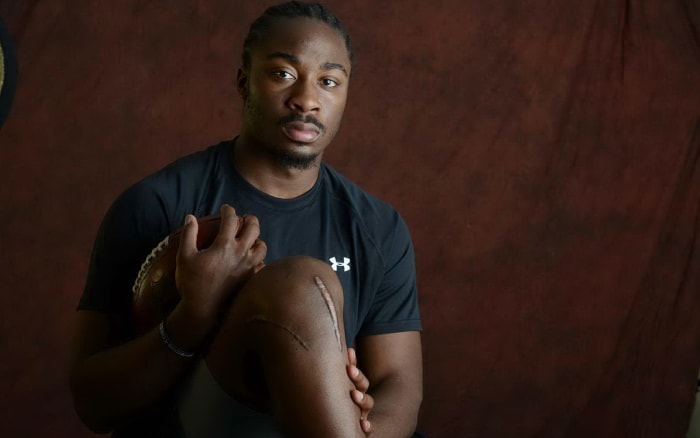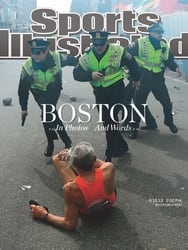Unbreakable
He was done.
He had to be.
No one could come back from that.
Time seemed to stop on the afternoon of Oct. 27. At Williams-Brice Stadium, where the upper decks feel as if they're swaying when South Carolina's football team excites its assembled fans, no one made a sound. "I've been there 12 years," says Jeffrey Guy, the Gamecocks' orthopedic surgeon. "I've never heard that stadium so silent." About 300 miles south, Florida and Georgia players warming up before their game in Jacksonville stopped and stared at the scoreboard, which carried the ESPN feed of Tennessee–South Carolina. About 130 miles northwest, Clemson coach Dabo Swinney and his wife sat at home and watched in horror. "My heart just broke," Swinney says. Similar sentiments rippled through the college football world.
Not Marcus.
Not now.
A few minutes earlier Guy and the rest of the medical staff had watched Marcus Lattimore, the junior tailback from Duncan, S.C., run for a 28-yard touchdown that gave the Gamecocks a 21–7 second-quarter lead. Lattimore had made one quick cut and burst between the right guard and right tackle, then outran the Volunteers to the end zone. That cut impressed Guy most. The doctor had been waiting to see Lattimore run with such confidence since he tore his left anterior cruciate ligament at Mississippi State in 2011. Finally, the 5' 11", 221-pound tailback resembled the old Marcus. "He looked," Guy says, "like he didn't have a care in the world." That Marcus wouldn't make it to halftime.
The play was called Power. When Lattimore took the ball from quarterback Connor Shaw, he liked what he saw. A bounce to the outside and he might have a lane. But Tennessee linebacker Herman Lathers appeared from behind the pile. He dived and, while in midair, encircled Lattimore's chest with his arms. Lattimore drove his right foot into the ground, hoping to surge forward and break free. "Probably a half a second either direction, and his legs would have cut out from under him like a normal tackle," Guy says. "But he was at that specific moment when his foot was planted in the ground and he was pushing off." At that instant, Vols cornerback Eric Gordon came in low and slammed into Lattimore's right knee. "If somebody is that heavy, running that fast," Guy says, "all the energy has to go somewhere." In other words, force equaled mass times acceleration.
"When the dude hit me, I didn't even feel it," Lattimore says. "I knew something was wrong. I thought I was dreaming. I really thought I was dreaming.... I guess I was in shock."
The hit had torn Lattimore's right ACL, peeled his lateral collateral ligament and his posterior cruciate ligament from the bone and damaged other connective tissue. With barely any ligaments intact to hold it in place, Lattimore's knee dislocated. Those pictures that appear to show the knee shifted unnaturally to the right of Lattimore's upper and lower legs? That's exactly what happened.
When South Carolina trainer Clint Haggard reached Lattimore and rolled him over, the knee popped back into place. Guy got to Lattimore a few seconds later and began to evaluate the damage.
The strong of stomach watched the ESPN replay. The rest heeded the advice of play-by-play man Dave Pasch, who suggested that viewers turn away if they didn't want to see something gruesome. It seemed as if the end of Lattimore's football career had just been televised. "I knew it was bad," Lattimore says. "I knew I might have to hang it up."
Exactly five months later, at South Carolina's pro day, Lattimore ran sewing-machine-precise ladder drills and showed off the stability of the surgically repaired knee with two huge stripes of scar tissue. When he finished his workout, the NFL coaches and scouts in attendance applauded. Lattimore remains confident he'll be ready to play for the team that drafts him when the 2013 NFL season begins. The change of outlook came thanks to some serious medical brainpower, buckets of sweat, a little good fortune and a lot of love.
The love came pouring in even as Lattimore lay on the field in tears. Typically when a player gets hurt, some teammates and an opponent or two will approach to offer words of encouragement. When Lattimore went down, South Carolina's entire squad came off its sideline and surrounded him. A few moments later the Vols came off their sideline to join the Gamecocks. "One of the most touching things I've ever seen in my life was the Tennessee players coming up to him," Guy says. "It was the whole freakin' team.... It still gives me chills when I think about it."
Yolanda Smith, Lattimore's mother, hadn't seen the play live. As usual, she'd been taking photos of players' families. She does that to take her mind off what might happen to her son on any given play and typically follows games by watching replays on the video screen. This time, though, there was no replay. Smith looked around and saw everyone in the Gamecocks' family section staring at her. "Go, Yolanda!" she remembers someone saying. The people parted, and Smith ran down to the field.
She couldn't bear to see her youngest in pain. She had worked her entire life to keep all five of her children—including a niece and nephew whom she raised—away from heartache. She had grown up in the Carver Homes projects in Atlanta, surrounded by poverty and drugs. She wanted better for her children. She bounced from Atlanta to the Pacific Northwest with her first husband, a military man. That marriage failed, as did a second, but the family eventually settled into a happy life in the northwest corner of the Palmetto State. "Nobody taught me how to be a parent," Smith says. "I just did the opposite of what I saw."
That includes taking photos of her eyeball and sending it to her young adult children on Friday and Saturday nights with the message, "I see you." Smith ran a tight ship, and Lattimore was the golden child, so well-behaved that he rarely needed discipline. According to his older sister, Eboni White, the worst transgression of Lattimore's childhood involved setting off a firework in the locker room at Byrnes High in Duncan. Lattimore admitted his mistake to his coach and paid penance by running hills. As the nation's No. 1--ranked tailback in 2010, Lattimore quickly impressed college coaches with humility and good manners. At South Carolina his teammates elected him captain. Even players from enemy schools loved Lattimore. "He's just a good guy," Clemson's Swinney says. "Even though he wears a rival's jersey, he's a guy to pull for." Smith had done her job with Marcus. She had prepared him for the world. But neither of them were prepared for this. As Marcus arrived in the training room with Guy, Yolanda wanted to erase her son's anguish; she wanted to trade legs.
I'm done.
Lattimore sobbed that phrase over and over. He couldn't stop crying. Meanwhile, Guy and Haggard asked him if he could feel his toes. NFL running back Robert Edwards suffered a similar injury in 1999 while playing in a beach football game in Hawaii during the week of the Pro Bowl. The knee dislocation had caused nerve damage, and Edwards lost feeling in his foot for a time. Had Lattimore damaged his peroneal nerve or his popliteal artery, his football career would be in serious jeopardy. "Marcus, wiggle your toes," Yolanda remembers telling her son in the training room and after he was taken to the hospital. "Move your feet."
Lattimore's toes worked. His feet worked. To Guy's astonishment, tests during the next few days showed no nerve damage, "which is really shocking, especially the way that he got hit," Guy says. "That's one of the most common ways that you get hit and cause a nerve problem." Tests revealed no damage to the blood supply in his leg either. They showed no cartilage damage. They showed no bone damage. The medical staff wouldn't know for sure until it performed the surgery to repair the ligaments, but it seemed as if Lattimore might have a chance at a full recovery. In the NFL, Vikings tailback Adrian Peterson was running through the league on an ACL repaired only the previous December. With a successful surgery and a grueling rehab, Lattimore's NFL dream might survive.
On Nov. 2 in Birmingham, Guy teamed for the second time in 13 months with his former boss, noted orthopedic surgeon James Andrews, to fix one of Lattimore's knees. Andrews, a former LSU pole vaulter, repaired Peterson's ACL, as well as that of Robert Griffin III. Andrews and Guy, along with Alabama-based surgeon Lyle Cain, spent more than three hours reconstructing Lattimore's knee and repairing other ligament damage on the outside of the joint. The best news? The preliminary tests had been correct; Lattimore had no nerve damage and no blood-supply damage. He could potentially return to the football field.
By the time of the surgery, Lattimore knew how many people wanted to see him play again. He received get-well wishes from every state and notes from as far away as Brazil and Finland. At an elementary school in Kentucky, students spelled out Lattimore's jersey number—21—on an empty field and sent him the overhead photo. Georgia football coaches had their entire team sign a ball for Lattimore. Clemson players and coaches signed a giant poster that asked God to give Lattimore the "strength, endurance, healing and courage" to recover.
The most encouraging messages came from former Hurricanes. One came from Willis McGahee, who tore his ACL in the Fiesta Bowl on Jan. 3, 2003, and recovered sufficiently quickly to get drafted No. 23 overall by Buffalo. The other was from Frank Gore, who tore both ACLs at Miami, dropped into the third round in '05, and in '11 broke the 49ers' career rushing record. The NFL vets reassured Lattimore that he, not his knee, would control his future. "They both said the same thing," Lattimore says. " 'It's all in your mind.' "
Lattimore announced in December that he would skip his senior season at South Carolina. Then he relocated to Gulf Breeze, Fla., where he undertook daily rehab sessions at the Andrews Institute and daily strength sessions next door at the Athletes' Performance training center. By then, the defeat he felt on the field that day in October had drained away. It had been replaced by the same determination that had driven Lattimore to break South Carolina's school record for rushing touchdowns even in an injury-shortened three-year career.
To Lattimore's surprise, the rehab on his right knee didn't hurt as much as that on his left knee a year earlier. McGahee and Gore were right. Much of the discomfort in the previous rehab stemmed from the fear of using the repaired knee. Now that Lattimore knew from experience that those exercises would help him, he didn't fear them. After Lattimore had recovery breakthroughs in January—doing box jumps, single-leg squats and running in a pool—he went to a Senior Bowl practice in Mobile and told NFL people he could be ready to play on opening day of the season. In early March, when physical therapist Stephen LaPlante asked Lattimore to catch balls while squatting against a wall for a minute or more, Lattimore didn't worry. And when LaPlante told Lattimore to perform the drill four more times, Lattimore didn't blink. "He won't cut a corner," LaPlante says.
During his first ACL rehab, Lattimore watched Peterson's workouts on YouTube and tried to emulate them. This time, he is working off a rehab protocol written by the same person who designed Peterson's rehab, and Lattimore cites Peterson's recovery as an inspiration.
The specter of Peterson—who rushed for 2,097 yards in 2012, less than 10 months after having his ACL repaired—looms over Lattimore's rehab as well as the rehab of almost every football player coming off ACL reconstruction. Andrews worries that Peterson's unusual recovery has spurred unrealistic goals. "[Peterson's] situation is good for him," Andrews says, "but it could also be bad, because it gives other people the wrong impression that they can do the same thing." The challenge, Andrews says, is pushing the recovering athletes without damaging the healing ligaments. This is especially true for players who suffered an injury as violent as Lattimore's. "You've got to be careful with someone who has had that knee injury—particularly if they're aggressive about it," Andrews says. "They do too much, too fast. I'm constantly back here making sure they don't get too far ahead of Mother Nature."
Lattimore wants to move faster at times, but he has heeded Andrews, Guy, LaPlante and strength coach Russ Orr. That's why he hasn't made Week 1 a hard-and-fast deadline. "I know my body," Lattimore says. "I understand being ready to go and waiting if I have to." Still, former LSU defensive linemen Bennie Logan and Sam Montgomery stood slack-jawed in March as they watched Lattimore push a heavy sled back and forth on a track at Athletes' Performance. Lattimore believes he could have run for scouts at South Carolina's pro day on March 27, but he didn't want to take the risk. He has enough dazzling runs on film to impress scouts, and his job as the draft approaches is to impress NFL team doctors and convince NFL general managers that he is worth the risk of a high draft pick. Those doctors poked and prodded Lattimore at the combine in February, and his knee will undergo more scrutiny by teams as the draft draws closer. It helps that Lattimore has the Andrews label on his surgery.
Lattimore knows NFL people already like him as a human being. That was made obvious by the ovation at his pro day. "You don't do that at pro days," says an NFL team employee who attended. But some general manager will have to decide if Lattimore is worth the investment as a football player after two knee surgeries. That makes predicting where Lattimore will go in the draft nearly impossible. "I can't do anything about it," Lattimore says. "If they like me, they like me. If they don't, they don't."
Lattimore has watched a replay of the injury only twice. "It really didn't feel like me," he says, "because it looked like it hurt." Andrews, meanwhile, saw a replay in early March. "That's the best look I'd gotten at it," Andrews says. "It scared the hell out of me after the fact."
Because of visceral reactions like that one—from the guy who knows better because he actually repaired the knee—Lattimore understands why the speed of his recovery produces shock. He knows NFL G.M.'s are like everyone else who stopped and stared when they saw his knee floating on the outside of his leg. That day someone started a false rumor that Lattimore had broken his femur. Lattimore wants to make clear to anyone who saw his injury that nothing about him is broken. And for the team that has enough faith in Lattimore to draft him, he hopes to prove as much in September. "This is going to be a great story," Lattimore says. "I promise you that."



